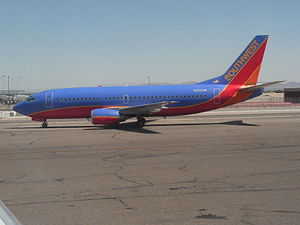On Friday, a Southwest Airlines flight lost cabin pressure after the fuselage ruptured. This is not the first time that this has happened, of course. There was an unrelated incident last year where a Southwest plane made an emergency landing after decompression, and Southwest has even grounded some of its fleet before.
To our knowledge, based on their statements, the airline was in compliance with all safety procedures and requirements. The 737-300 was delivered in 1996, and Southwest uses its fleet very aggressively. That is why aircraft inspections are based on cycles(numbers of takeoffs and landings), as opposed to age. But if airplanes are breaking open at 36,000 feet, even at the rate of one a year, that means regulations need to be changed.There are nearly 300 737-300s operating in the U.S. alone out of nearly 1000 worldwide.
Southwest grounded aircrafts of the same type for intense inspections. Their crew, from all reports, acted professionally and no one was injured.
“Our highest priority is the safety of our Employees and Customers,†a Southwest representative commented. “Prior to the event regarding Flight 812, we were in compliance with the FAA-mandated and Boeing-recommended structural inspection requirements for that aircraft. What we saw with Flight 812 was a new and unknown issue. We regret any Customer inconveniences as a result of the inspections currently underway. Delays and cancellations are never the preference, however we are taking every precaution we can to ensure that our operation is safe.â€
As we said, that is all you can really hope for. In 1988, an Aloha Airlines 737 suffered a loss of a large section of the roof of the aircraft. A flight attendant was blown out of the aircraft and was the only fatality. Such accidents are dramatic examples of the extent of damage to an aircraft. Despite that level of damage, the pilots were still able to land the aircraft.
Airplanes are simultaneously built with such safety and redundancies and are surprisingly fragile. Care must be taken to ensure they remain safe. While grounding of aircraft and the subsequent cancellation of flights are inconvenient, they are better than the alternative. The inspections have already borne fruit, as several aircraft showed signs of similar cracking which could have led to an incident. Will this mean that all aircraft will be inspected to this level going forward? We’ll have to wait and see what the FAA will do.
Related articles
- Why Planes Fall Apart (thedailybeast.com)
- Southwest Airlines Continues Inspections of 737-300 Fleet (blogsouthwest.com)
- Southwest Airlines Flight 812 (blogsouthwest.com)
- Update on Southwest Airlines Flight 812 (blogsouthwest.com)
- Southwest Airlines Works to Minimize Customer Delays As It Inspects Aircraft (blogsouthwest.com)

